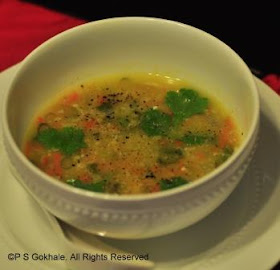This is the first time I made this recipe and it was also the first time that all of us tasted Phirni. It was well received by everyone. My husband gave it a great review and told me that it was a keeper. It is a recipe my mom made this festive season, and when she told me how to make it, I was very enthusiastic to make it. It is a relatively easy recipe and doesn't take a lot of effort, and tastes fabulous. You do need to plan for it a few hours ahead at least, as there is some pre-preparation, soaking time needed and then you need an hour or two of cool down time, as it is to be served cold. It is an easy recipe, with high returns, that you can make for any celebratory occasion or just for everyday dessert.
Ingredients
2 tbsp ghee/clarified butter
3 cloves
1 cinnamon stick,1/2 inch
1/4 cup rice
1/2 cup sugar
4 cups milk
a pinch of saffron
1 green cardamom, peeled and powdered
almonds, for garnish
raisins, for garnish
Method
Soak the rice for 1-2 hours (at least one hour). Drain the water and grind the rice coarsely. Heat the ghee in the saucepan. Then add the cloves and cinnamon stick and fry them for a minute till they are fragrant. Add the rice and cook it for a couple of minutes. The rice will puff up as it absorbs the ghee. Roast the rice for another minute or so. Don't let it turn brown. Then add the milk to this and boil till the mixture thickens. Make sure to stir as it cooks, so that the rice doesn't stick to the bottom and burn. Then, add the sugar. The mixture will become a little liquidy again as the sugar dissolves to form syrup. Add the saffron and cook for a few more minutes. Then add the cardamom powder. The mixture should be thick, like a porridge. At this stage you can add in almonds and raisins. Pour the phirni into the serving cups/ramekins. Cool for at least one to two hours before serving. Serve cold. As it cools, it will set and become like a thick pudding or custard. Garnish with almonds and raisins before serving. Traditionally this is served in small earthen pots, however you can serve in any dessert bowls.
Tips
Make sure to pour it into the serving dishes before it cools, so that it sets properly. This does need a little bit of attention and some stirring to make sure that the rice doesn't stick to the bottom and burn. It is easier to make this in a non stick saucepan. Cook it on low heat. If you are cooking it in a steel vessel, stir more frequently (not continuously).
Ingredients
2 tbsp ghee/clarified butter
3 cloves
1 cinnamon stick,1/2 inch
1/4 cup rice
1/2 cup sugar
4 cups milk
a pinch of saffron
1 green cardamom, peeled and powdered
almonds, for garnish
raisins, for garnish
Method
Soak the rice for 1-2 hours (at least one hour). Drain the water and grind the rice coarsely. Heat the ghee in the saucepan. Then add the cloves and cinnamon stick and fry them for a minute till they are fragrant. Add the rice and cook it for a couple of minutes. The rice will puff up as it absorbs the ghee. Roast the rice for another minute or so. Don't let it turn brown. Then add the milk to this and boil till the mixture thickens. Make sure to stir as it cooks, so that the rice doesn't stick to the bottom and burn. Then, add the sugar. The mixture will become a little liquidy again as the sugar dissolves to form syrup. Add the saffron and cook for a few more minutes. Then add the cardamom powder. The mixture should be thick, like a porridge. At this stage you can add in almonds and raisins. Pour the phirni into the serving cups/ramekins. Cool for at least one to two hours before serving. Serve cold. As it cools, it will set and become like a thick pudding or custard. Garnish with almonds and raisins before serving. Traditionally this is served in small earthen pots, however you can serve in any dessert bowls.
Tips
Make sure to pour it into the serving dishes before it cools, so that it sets properly. This does need a little bit of attention and some stirring to make sure that the rice doesn't stick to the bottom and burn. It is easier to make this in a non stick saucepan. Cook it on low heat. If you are cooking it in a steel vessel, stir more frequently (not continuously).






















